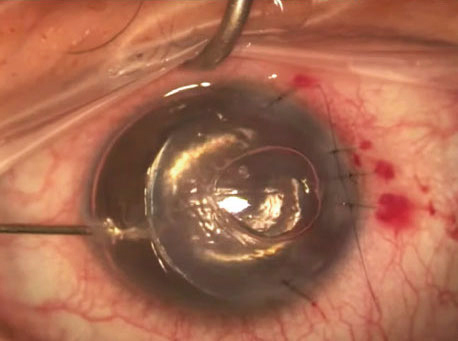 |
DSAEK patients in this study experienced a clinically insignificant 0.2D myopic shift over time, which confirms that the grafts maintained stability and shape long-term. Photo: James Lewis, MD. Click image to enlarge. |
A recent study found that excellent best-corrected visual acuity (BCVA) can be achieved during the first decade following Descemet stripping automated endothelial keratoplasty (DSAEK) for Fuchs’ endothelial corneal dystrophy. However, the findings suggest that improvement appears to plateau after five years.
This research examined changes in BCVA, refractive error and central corneal thickness (CCT) during the first decade after DSAEK. The researchers reviewed outcomes of all consecutive eyes undergoing DSAEK for Fuchs’ dystrophy. They excluded eyes with untreatable comorbidities before DSAEK. The researchers assessed changes in BCVA, manifest spherical equivalent, manifest cylinder (vector analysis) and CCT. The inclusion criteria for this analysis was met in 96 eyes of 61 subjects.
Data, published in Cornea, showed that BCVA improved between six months and five years and then remained stable at 10 years. The study authors observed a myopic shift of -0.20±0.51D between six months and five years, which remained stable at 10 years. CCT was stable between six months and five years but increased at 10 years.
Changes in manifest refractive error were not clinically significant, according to the research team. They also reported that the gradual increase in CCT was consistent with longer-term changes found after other types of keratoplasty.
The study authors concluded that DSAEK provides excellent BCVA for at least a decade after surgery in eyes without other conditions that affect vision. Therefore, they noted, it is still an appropriate endothelial keratoplasty technique for eyes with ideal anatomy when needed.
“Although Descemet membrane endothelial keratoplasty (DMEK) has been advocated for eyes with complex anatomy to achieve the best possible vision, DSAEK can also offer maximum vision in many of these eyes because vision is limited by other factors (typically optic neuropathy or maculopathy),” the investigators stated in their recent paper.
“For patients with eyes with complex anatomy, knowing that DSAEK does not significantly limit best possible vision and that current evidence suggests DSAEK has longer graft survival than DMEK, DSAEK currently provides better longer-term function and value-based health care than DMEK.”
Patel SV, Hodge DO, Nau CB. Ten-year changes in vision, refractive error and corneal thickness after descemet stripping automated endothelial keratoplasty for Fuchs’ endothelial corneal dystrophy. Cornea. April 5, 2023. [Epub ahead of print]. |


